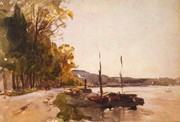Nathaniel Hone the Younger
Irish Landscape Artist. Biography, Paintings.
![]()
![]()
|
Nathaniel Hone the Younger |
 Banks of the Seine, Near Paris. 1860 |
Nathaniel Hone the Younger RHA (1831-1917)The famous exponent of landscape painting, Nathaniel Hone was born in Dublin to a family of great artistic renown. He was the great grand-nephew of Nathianiel Hone the Elder (1718–1784), and related to the portrait painters Horace Hone (1756-1825) and John Camillus Hone (1759-1836), as well as the future painter and stained glass artist Evie Hone (1894-1955). Nathaniel Hone started his career as a railway engineer, but at 21 determined to become a professional painter. |
|
MORE ABOUT ART IN
IRELAND |
|
|
In 1853, he began his art studies in Paris, and he remained in France for seventeen years. During his first four years he was taught drawing and figure drawing by Yvon and Thomas Couture (1815-1879) and studied the human form. Like all classically trained artists he also studied fine art painting by copying the pictures by the Old Masters in the Louvre Museum. After this, he travelled to Barbizon to study landscape painting. It was here that he encountered other artists such as Millet, Corot and Harpignies. This rigorous training in composition, and the portrayal of light on the canvas, helped him to absorb the essential painting techniques needed to become a master. In particular, it helped him to develop a deep feeling for the colour of a landscape and the skill to reproduce it, which made him one of the foremost Irish landscape artists. He retained a preference for tone rather than pure colour and, as with many Impressionist landscape artists a lifelong fascination with light. This is evident from his feeling for the muted tones of the Irish countryside, the variable light on different coastlines, shafts of sunlight on a field, and suddenly threatening clouds. |
|
Nathaniel Hone left Barbizon in about 1870, moving to Brittany, Normandy, Paris, and Italy before finally returning to Ireland in 1872. There, he married, honeymooned on the Continent then returned to Dublin, where he exhibited regularly averaging about four paintings in each annual exhibition of the Royal Hibernian Academy (RHA). He continued to travel widely, visiting Greece, Turkey and Egypt, where he produced numerous examples of Orientalist painting, being one of the first Irish artists to do so. In 1879, he was elected an associate member of the RHA, becoming a full member the following year. In 1894, he was elected Professor of Painting at the RHA, a post he held until his death. He settled in Malahide, where the local neighbourhood provided him with the scenes for many of his finest paintings. During this time Hone also befriended the master artist Walter Osborne, whose portrait he painted. As well as oil painting, Hone also produced a number of watercolour paintings. Paintings by Nathaniel Hone The Younger appear in many collections, including: The Ulster Museum, Belfast; Crawford Art Gallery, Cork; Hugh Lane Art Gallery, Dublin; National Gallery of Ireland; Royal Irish Yacht Club; National University of Ireland; British Museum; Tate Gallery, London; and many more. See also: Plein-Air Painting in Ireland. Most Expensive Painting By Nathaniel Hone the Younger The auction record for a work by Nathaniel Hone the Younger was set in 2008, when his Barbizon landscape painting, entitled The Boundary Fence, Forest of Fontainebleau, was sold at Christie's, in London, for £96,500. |
|
More Information About Visual Arts in Ireland • For details of other landscape artists,
see: Irish Artists: Paintings and Biographies. History
of Irish Art |